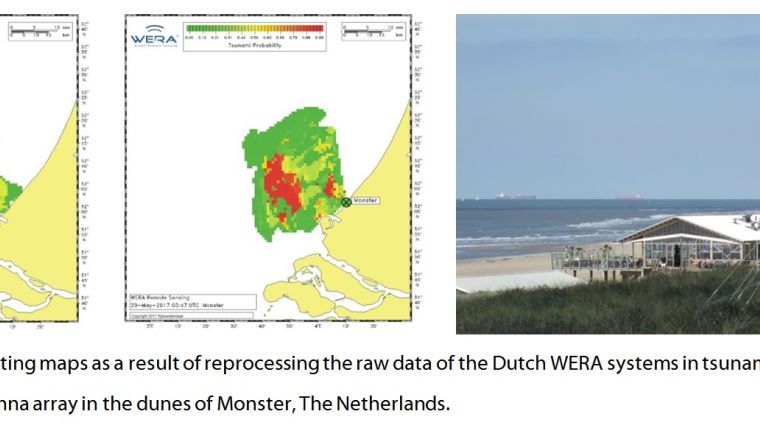Mini Tsunami Detected Using Wave Radar
On 29 May 2017, a “mini tsunami” hit the Dutch coast with a flood wave of more than 2m high which swept away beach chairs, boats and parasols. Thanks to the fact that this wave reached the beaches very early in the morning at about 5:30am local time, nobody was seriously injured.
About 50km south-west of Zandvoort there are two WERA ocean radar systems installed at Monster and Ouddorp. These systems are owned by Rijkswaterstaat (a part of the Ministry of Infrastructure and the Environment) and measure the ocean currents around the entrance of the Port of Rotterdam. The operational frequency is 16.175MHz providing a coverage of up to 70km offshore to measure ocean surface current velocity and direction. Even though WERA can be used for Tsunami detection as well, these particular systems are operated in a standard oceanographic mode. For this reason no tsunami alert was issued by the systems.
Nevertheless, after re-processing the acquired WERA raw measurements from both systems using the original WERA Tsunami detection software, specific ocean current signatures, generated by the approaching tsunami-like wave, can be seen clearly more than 40 minutes before the wave flooded the coast near Zandvoort.
Although the ‘mini tsunami’ monitored at the Dutch coast was not a real tsunami, but a so called ‘Stokes flow’ or meteotsunami, the flooding effect at the coast was quite the same. This phenomenon is quite rare in the North Sea region, but it is widely-known and caused damages at various places around the world, e.g. at the Mediterranean coast, in Asia, Australia, and North America.
Tsunami detection by means of an ocean radar based on the effect that an approaching tsunami wave is generating a unique signature of the ocean surface current. This current signature can be detected by an ocean radar already far off the coast.
Tsunami Detection History
Since 2011, a robust real-time tsunami detection software for WERA has been available and is already installed in Asia and America. The software provides maps of tsunami probability in near real-time as well as an alert message transfer. The tsunami probability is displayed for each grid point of the radar coverage. Using such approach, the WERA system provides a visualization of the tsunami alert far offshore and therefore supports decision-making process at the disaster warning centres to issue an alarm.
On 14 October 2016, the WERA tsunami detection system installed near Tofino on Vancouver Island, Canada, issued an automatic Tsunami alert. A Tsunami signature in the surface currents was detected about 60km offshore, more than 20 minutes before the wave reached the shore.
The days around 14 October were characterised by strong winds and rough sea state caused by the remnants of typhoon Songda 2016, a tropical disturbance formed west-south-west of Hawaii which struck the Pacific Northwest region of the United States and Canada as a powerful extratropical cyclone. The sudden change in atmospheric pressure caused the meteotsunami observed near the coast of Tofino.
It was the first time that a tsunami was detected in real-time by HF Radar in operational Tsunami mode. Although this meteotsunami was a small one with a wave height of 20cm only, the signature was seen clearly. This event demonstrates the potential of WERA for tsunami detection and its value for early warning systems.
The development of this Tsunami detection and alerting software was already started in 2005 after the 2004 Tsunami in the Indian Ocean. HELZEL Messtechnik in co-operation with the University of Hamburg developed methods to recognise the Tsunami generated signatures in the surface currents which are superimposed onto the usual ocean currents typically driven by tides, winds or river outflow.
The array type version of the ocean radar WERA has the unique performance to provide ocean current data in high resolution within a delay of 2 minutes which is sufficient for time critical applications like tsunami warnings. For this reason, Helzel offers the tsunami package with its high-end WERA systems only.
In Europe, these WERA systems are not yet used for tsunami alerting even though several stations are operational for oceanographic purposes. The systems can be upgraded by modifying the hardware and installing a tsunami software package.














